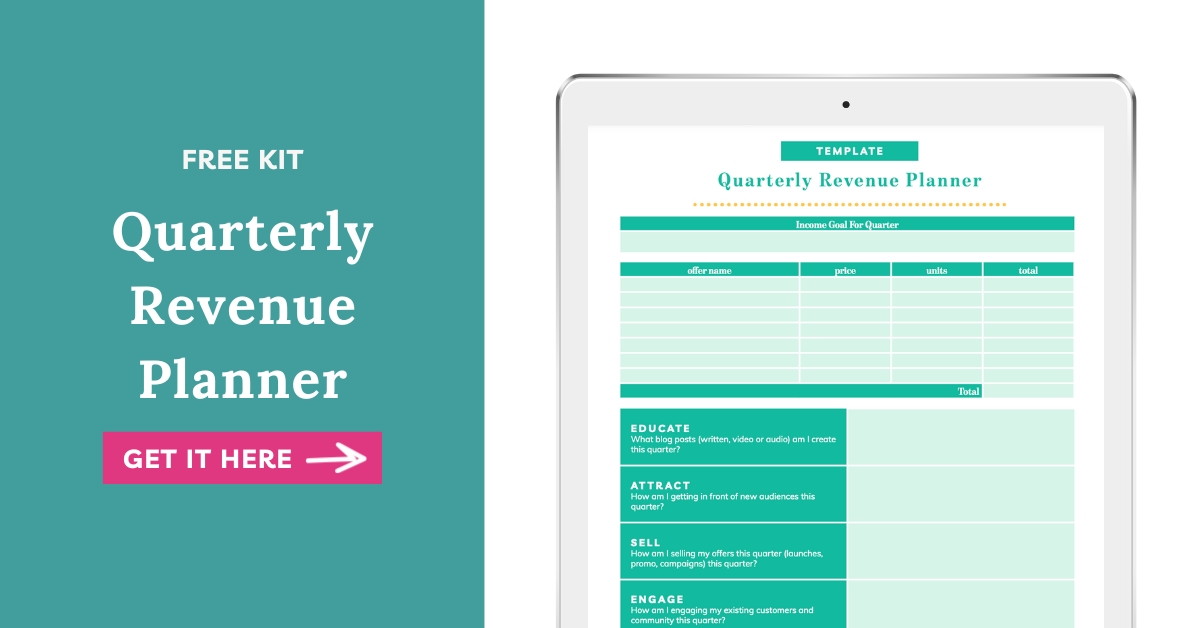
Sign up to get instant access to the Quarterly Revenue Planner!
Want more profitable + strategic content? Grab my free content planner!


I’m Hailey – content strategist and founder here at Your Content Empire where we help you create more profitable, purposeful and productive content — and hopefully enjoy yourself more while doing it too. Learn more about me here >>

When it comes to your quarterly revenue plan – are you on track, below target or have you not even set one? As we near the end of each quarter, business owners are getting ready to reflect on the revenue goals they’ve set.
During this time, one of two emotions usually come up:
Disappointment or satisfaction.
You either blew right past that goal, are on track to hit it, or you’ve realized that reaching that revenue goal is unlikely.
So where do you fall?
I’ve talked to many business owners this year who are ready to throw in the towel on their goals OR have already hit them and so don’t know what to do next.
In both cases, the question is, “Do I give up now or set another goal that is achievable?”
In this blog post, I’m going to walk you through how to assess where you are and create a revised quarterly revenue plan to finish the year on a more profitable foot!
I’ve created a Quarterly Revenue Planner PDF that you can download here to follow along with this blog post and create your revenue plan!
The first step is to look back at your original annual revenue goal. I know it’s easier to not look and just move forward, but there’s a ton of valuable info to be gleaned from this reflection step.
Where are you at revenue-wise in relation to that goal?
Pull together:
If you’re ahead of your goal, do your favourite happy dance in celebration and then ask yourself:
If you are below target for your goal:
Next – and especially if you’re in the majority of those who are looking like they might not meet that big annual goal they set for revenue – I want you to play a little what-if game before we start the quarterly planning process.
Consider this: What would it look like if you did meet your annual revenue goal in the time left this year? What would it take? What are potential paths that could get you there (in terms of # offers sold)?
Even if it’s a pie in the sky goal at this point, I want to help you get your opportunity-focused lenses on before we get to building your quarterly revenue plan.
Especially if you’re falling short, it’s easy to feel like nothing’s going to work – that’s definitely not the vibe or outlook we want to be bringing to this planning process!
One of the downfalls to annual revenue planning comes when you don’t break that revenue goal up to tackle in smaller chunks of time. So by the time you get to the final quarter of the year (the 11th hour), it feels like it’s all-or-nothing.
So our first step is to set a revenue goal for the next three months. Well, actually two goals – (1) a happy goal (something that feels a little stretchy but achievable if you work at it) and (2) a 10X goal (inspired by Grant Cardone’s book The 10X Rule and basically your happy goal times 10).
This range becomes your goal for the quarter – although you work and plan as if you’re going for the 10x goal. Because if you shoot for that one, hitting your happy goal becomes a no-brainer.
For example:
If my happy goal for the quarter was $20,000
My 10X goal would be $200,000
And if I act as if my goal is $200,000 and work on believing it (even if it feels a little far-fetched), the $20,000 will feel easy.
Next, we want to come up with a plan for the offers (and quantities) you’re going to sell that’ll get you to that number. You can set 2 numbers for each here based on the happy goal and the 10x goal.
These will be the targets that you’ll shoot for when running your promotions and sales campaigns this quarter.
We know the offers you want to sell and how many of each – now it’s time to plan out how you’re going to sell them.
You’re planning for the next three months – so what will you focus on selling when? Because a big mistake here would be trying to sell all of your different offers at the same time – so instead give each offer a time to shine where you’ll focus 100% on generating and closing leads for that offer.
For each month of the quarter –
Even though your marketing plan will pick up from here, you still want to have at least a high-level revenue plan of how you’re going to make that revenue goal happen!
Now is when I like to pull out or print off a calendar and begin blocking out the dates of my promotions or campaigns. I also like to think about how far in advance I need to start priming my audience on the topic and block that time out too.
Seeing it on a calendar like this helps you see where you are either not leaving enough time or where you have huge gaps that you could perhaps add something else in promo-wise.
Finally, in order for this plan to work, you’re going to have to take action on it and measure regularly to make sure you’re moving in the right direction.
There are two types of metrics you want to look at regularly:
So for your revenue plan, identify your own leading metrics. What would have to happen in order for you to hit your goal? Is it a number of people you’re reaching out to? Is it the number of inquiries? Or sign-ups for your sales funnel?
Then measure those on a weekly (or even daily) basis and the lagging metrics during your monthly recap.
Now you know the seven steps of creating a quarterly revenue plan you’ll actually reach, from assessing your original goals to creating new plans and targets, and finally how to put it all into action. By following these steps, you can set your goals exactly where they need to be so you’re making goals that are ambitious but still attainable.
Simply sitting back and reading a blog post without taking action? Not you, my friend. Get the Quarterly Revenue Planner and start putting this into action!
In this blog post, I'm giving you a done-for-you marketing plan for service businesses because being a service-based business owner sometimes feels impossible. You’re working in the business, so much, serving your clients. That it can often leave less and less time...
Most of the problems with your current content strategy can be fixed with one tiny shift—changing how you plan your content. Specifically your monthly content planning process which we're covering in this post ↓ The issue with the typical approach is that people make...
Do you have a monthly membership that you’re struggling to get new members in? Or maybe you have a steady stream of new members, but you want to scale it so you have a higher monthly recurring revenue? In this video, I’m giving you the ultimate monthly marketing plan...